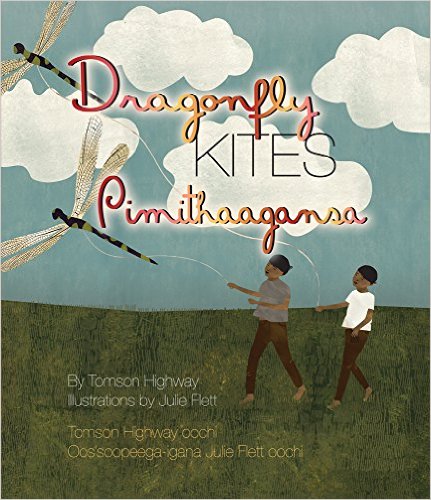| ________________
CM . . .
. Volume XXII Number 41. . . .June 22, 2016

 |
Dragonfly Kites = Pimithaagansa.
Tomson Highway. Illustrated by Julie Flett.
Markham, ON: Fifth House, 2016.
32 pp., hardcover, $19.95.
ISBN 978-1-89725-263-5.
Subject Headings:
Cree children-Canada-Juvenile fiction.
Dragonflies-Juvenile fiction.
Preschool-grade 1 / Ages 4-6.
Review by Meredith Harrison-Lim.
**1/2 /4
|
| |
|

excerpt:
One summer, Joe and Cody made a pet of a baby Arctic tern. They called him Freddy. Another summer, their pet was a baby loon named Sally. Sally wasn’t very good at walking, but she swam well.
The boys named the squirrels and the rabbits and the chipmunks that ate from their hands. They even had names for the ants.
They once had two baby eagle friends. They named one Migisoo, which means “eagle” in Cree. The other they named Wagisoo, which doesn’t mean anything but rhymes with Migisoo.
Dragonfly Kites is a story of two brothers, Joe and Cody, who spend their summers with their parents and their dog, Ootsie, at different lakes each year in northern Manitoba. They sleep in a tent, far away from other people. The brothers are very creative, playing games and making friends with different items they find in the environment around them and the animals they meet on their travels. Out of all the animals, their favourite summer pets are dragonflies. They chase the dragonflies as if they are kites until they reach the shore and can follow no further. However, in their dreams. they are able to chase the dragonflies over the water and into the sky.
This story is bilingual, written in English and Cree. It is the second book in Tomson Highway’s “Magical Songs of the North” trilogy, featuring the same brothers from Caribou Song. The text is very simple, allowing readers to imagine free summer days spent in nature. While the story is about two Cree brothers and their adventures, children of different ethnic and cultural backgrounds will likely be able to relate to developing relationships with the creatures they find in nature and, by using their imaginations, to experience the outdoors to the fullest. However, in contrast to many children, nothing in the story indicates that Joe and Cody additionally yearn for modern technological devices to help fill their days. Rather, in Dragonfly Kites, nature and the boys’ imaginations are portrayed as being more than enough to provide them with joy and contentment.
Unlike most fiction, Dragonfly Kites does not follow a standard plot line. Like the dragonfly kites that the boys follow, the plot simply glides along until the boys wake up from their dream. This is appropriate due to the significance the illustrations play in this picture book, as well as the age of the intended audience. Readers are not overwhelmed by the storyline and are free to appreciate the accompanying illustrations.
The illustrations in Dragonfly Kites act as an extension of the story. The pictures in the book are colourful, beautiful, and have an austere, stark quality. This is consistent with other works produced by award-winning illustrator Julie Flett. This style suits the story as, aside from the nature that surrounds around them, Joe and Cody are depicted as being by themselves. While they live with the parents, their adventures occur when their parents are fishing without them. The full-page illustrations demonstrate the vast space that surrounds the boys.
Recommended.
Meredith Harrison-Lim is a MLIS graduate working for the Federal Government in the National Capital Region.

To comment
on this title or this review, send mail to cm@umanitoba.ca.
Copyright © the Manitoba Library Association. Reproduction for personal
use is permitted only if this copyright notice is maintained. Any
other reproduction is prohibited without permission.
Next Review | Table of Contents For This Issue - June 22, 2016
CM Home | Back Issues
| Search
| CM Archive
| Profiles Archive
|
